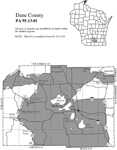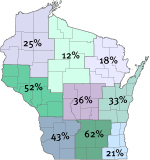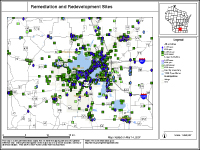      |
 |
| |
Dane County |
| |
The Find Section provides the most current
information and data found, as of May 2007, unless
otherwise noted. |
| |
|
| |

|
| |
SOURCES
OF DRINKING WATER
Wisconsin enjoys a generally clean
and abundant groundwater resource.A2 This resource is present because of the
state’s geologic history and climate; this resource is protected
through strong state and federal regulations, and the cooperative efforts of
water systems, trade associations, individual operators, planning commissions,
and state and federal science agencies.
Drinking water in Wisconsin is provided
by either public water systems or private wells. A public water system is defined
as a system that provides public water for human consumption, if such a system
has at least 15 service connections or regularly serves an average of at least
25 individuals daily at least 60 days out of the year. Wisconsin has nearly 11,500
public water systems which meet the daily water needs of about 4 million people.A1 The Wisconsin
Department of Natural Resources (WDNR)A3 oversees these public systems, and
additional information can be found online.
Public water systems that are owned by a community are called municipal
water systems.A4 Dane County has 34 municipal
water systems. 
In addition to the public water systems, about 850,000
private wells provide drinking water to Wisconsin's population. Unlike public
water systems, protection and maintenance of a private well is largely the responsibility
of homeowners. Information on how to build and protect your private water supply
can be found on the WDNR
web site.A5 The USGS is finalizing the "Summary of Water
Use in Wisconsin for 2005." When released, this summary will show the percentage
of the Dane County population whose drinking water comes from private wells versus
municipal systems.
return to top
|
| |
GROUNDWATER
PROTECTION POLICIES
WELLHEAD PROTECTION PLANS AND ORDINANCES 
- 16 of 34 municipal water systems
in Dane County have a wellhead protection plan: Blue Mounds, Cottage Grove, Deerfield,
Fitchburg, Madison, Marshall, Mazomanie, Morrisonville, Oregon, Stoughton, Sun
Prairie, Token Creek, Town of Burke, Waunakee, Westport and Windsor.B1
- 14 of 34 municipal water systems
in Dane County have a wellhead protection ordinance: Blue Mounds, Cottage Grove,
Deerfield, Fitchburg, Madison, Marshall, Mazominie, Oregon, Stoughton, Token
Creek, Town of Burke, Waunakee, Westport and Windsor.B1
|
For recommendations of groundwater protection policies
and some outstanding examples of innovative groundwater protection policies adopted
by other communities see Groundwater
Protection Policies.
|
|
Wellhead protection plans are developed to achieve
groundwater pollution prevention measures within public water supply wellhead
areas. In some areas of the state, sophisticated groundwater flow modeling techniques
were used to delineate source
water areas for municipal wells. A wellhead protection
plan uses public involvement to delineate the wellhead protection area, inventory
potential groundwater contamination sources, and manage the wellhead protection
area. All new municipal wells are required to have a wellhead protection plan.
A wellhead protection ordinance is a zoning ordinance that implements the wellhead
protection plan by controlling land uses in the wellhead protection area.B2
Of those municipal water systems that have wellhead
protection (WHP) plans, some have a WHP plan for all of their wells, while others
only have a plan for one or some of their wells. Similarly, of those municipal
water systems that have WHP ordinances, some ordinances apply to all of their
wells and others just one or some of their wells.
ANIMAL WASTE MANAGEMENT ORDINANCES
- Dane County has adopted an animal
waste management ordinance.B3
Most Wisconsin counties have adopted an animal waste
management ordinance that applies to all unincorporated areas of the county
(areas outside of city and village boundaries). While the purposes of such ordinances
vary among counties, a key purpose is often to protect the groundwater and surface
water resources. This is accomplished by regulations such as:
- Permitting of animal waste storage
facilities;
- Permitting of new and expanding feedlots;
- Nutrient management;
- Prohibiting:
- Overflow of manure storage structures;
- Unconfined manure stacking or piling
within areas adjacent to stream banks, lakeshores, and in drainage channels;
- Direct runoff from feedlots or stored
manure to waters of the state;
- Unlimited livestock access to waters
of the state where high concentrations of animals prevent adequate sod cover
maintenance.
More information is available from the WDATCP.
ADDITIONAL GROUNDWATER PROTECTION POLICIES
Your county may have additional policies in place
for groundwater protection. A good way to find out is to check with the county
conservationist and local zoning administrators.
return to top
|
| |
MONEY
SPENT ON CLEANUP
PETROLEUM ENVIRONMENTAL CLEANUP FUND AWARD
- Over $120 million
have been spent in Dane County on petroleum cleanup from leaking underground
storage tanks, which equates to $259 per county
resident.C2
The Petroleum Environmental Cleanup Fund Award (PECFA)
program was created in response to enactment of federal regulations requiring
release prevention from underground storage tanks and cleanup of existing contamination
from those tanks. PECFA is a reimbursement program returning a portion of incurred
remedial cleanup costs to owners of eligible petroleum product systems, including
home heating oil systems.C1
As of May 31, 2007, $120,317,452 have
been reimbursed by the PECFA fund to clean up 837 petroleum-contaminated
sites in Dane County. This equates to $259 per
county resident, which is similar to the
statewide average of $264 per resident.C2
NITRATE REMOVAL SYSTEMS
- 3 municipal
water systems in
Dane County have spent money to reduce nitrate levels.
As of 2005, over 20 municipal water systems in Wisconsin
have spent over $24 million reducing nitrate concentrations in municipal water
systems.C3 Spending to reduce
nitrate levels in municipal wells in Dane County is shown in the table below.
Municipal
water system
|
Type
of treatment
|
Total
|
Cost
per person |
Annual
maintenance
|
| Fitchburg |
Inactive
well, will be abandoned
|
$1,009,000
|
$49
|
$200
|
| Morrisonville |
New
well
|
$279,000
|
$698
|
|
| Waunakee |
Well
reconstruction
|
$69,694
|
$7
|
|
return to top
|
| |
GROUNDWATER
USE
- From 1979 to 2005, total water use in Dane County has fluctuated from about
53.0 million gallons per day to 70.2 million gallons per day.*
- The fluctuation in total water use over this period is due to all categories
of usage.
- The proportion of county water use supplied by groundwater has been consistently
above 97% from 1997 to 2005.*
As part of the National Water-Use Information Program,
the USGS stores water-use data in standardized format for different categories
of water use. In 1978, the USGS entered into a cooperative program with the WDNR
to inventory water use in Wisconsin. Since that time, five reports summarizing
water use have been published (Lawrence and Ellefson, 1982D2;
Ellefson and others, 1987D3;
Ellefson and others, 1993D4;
Ellefson and others, 1997D5;
Ellefson and others, 2002D6;
Buchwald and others, 2008D7).
Water use in Wisconsin in these summary reports is
reported in the following categories: domestic, livestock, aquaculture, industrial,
commercial, public use and losses, thermoelectric or mining. References describing
the methods for collecting data and estimating water use are provided in the
summary reports.
* Thermoelectric and mining data are not
considered in water-use tables or figures on this web site. Thermoelectric-power
water use is the amount of water used in the process of generating thermoelectric
power. The predominant use of water is as non-contact cooling water to condense
the steam created to turn the turbines and generate electricity. D1
return to top
|
| |
SUSCEPTIBILITY
OF GROUNDWATER TO CONTAMINANTS
In Wisconsin, 70% of residents and 97% of communities rely on groundwater
as their drinking water source. Wisconsin has abundant quantities of high-quality
groundwater, but once groundwater is contaminated, it's expensive
and often not technically possible to clean. Because of these factors, we need
to be careful to protect our groundwater from contamination. Our activities
on the land can contaminate groundwater - most contaminants originate on the
land surface and filter down to the groundwater. In some cases however,
groundwater can become contaminated from natural causes such as radioactivity
due to the presence of radium in certain types of rocks.
READ
MORE ABOUT SUSCEPTIBILITY
“Susceptibility of Groundwater to Pollutants” is defined here as the ease with which a contaminant can be transported from the land surface to the top of the groundwater called the “water table”. Many materials that overlie the groundwater offer good protection from contaminants that might be transported by infiltrating waters. The amount of protection offered by the overlying material varies, however, depending on the materials. Thus, in some areas, the overlying soil and bedrock materials allow contaminants to reach the groundwater more easily than in other areas of the state.
In order to identify areas sensitive to contamination, the Wisconsin Department of Natural Resources, in cooperation with the University of Wisconsin-Extension, Wisconsin Geological and Natural History Survey and the USGS, has evaluated the physical resource characteristics that influence this sensitivity.
Five physical resource characteristics were identified as important in determining how easily a contaminant can be carried through overlying materials to the groundwater. These characteristics are depth to bedrock, type of bedrock, soil characteristics, depth to water table and characteristics of surficial deposits. Existing statewide maps of these five characteristics were used whenever possible. New maps were compiled when existing information wasn’t already mapped. The resource characteristic maps used in this project were compiled from generalized maps at a scale of 1:250,000 or 1:500,000.
Each of the five resource characteristic maps was put into digital form using a Geographic Information Systems (GIS) program. All of the information contained in the five maps were overlaid and combined into one composite map. A numeric rating scheme developed for each map was used to score the maps and the five resource map scores were added together within GIS. The composite map shows the scores for each area – low scores represent areas that are more susceptible to contamination and high scores represent areas that are less susceptible to contamination.
The method described above is a subjective rating method; specifically an index method. An index method assigns a subjective ratings or score to physical resource characteristics of an area to develop a range of contamination susceptibility categories (ranging, in this case, from more susceptible to less susceptible). Index methods are fairly popular approaches to groundwater susceptibility, because they are quick and straightforward, and they use data that are readily available. However, the mapped distribution of susceptibility categories produced by an index method is typically fraught with uncertainty, primarily due to the subjectivity in the approach. The susceptibility categories include little quantifiable or statistical information on uncertainty and this limits their use for defensible decision making. So while susceptibility maps produced using index methods can be useful, their inherent uncertainty must be kept in mind. (National Research Council, 1993E1; Focazio and others, 2002E2).
return to top
|
| |
GROUNDWATER
QUALITY
NITRATE
- 79%
of 2,624 private
well samples collected in Dane County from 1990-2006 met the health-based drinking
water limit for nitrate-nitrogen.
Of the 2,624 samples that have
been collected in the county, 1,372 samples (52%) contained between 2 and 10
mg/L (milligrams per liter, or parts per million) nitrate-nitrogen, and serve
as indicators that land use has likely affected groundwater quality. An additional
543 samples (21%) exceeded the health-based drinking water limit of 10 mg/L nitrate-nitrogen.F1
As shown in the map on the right, the samples where
nitrate-nitrogen levels were elevated are located throughout
the county.F2
Introduction and Sources of Nitrate
In 2006, the WDNR and the Wisconsin Department of
Agriculture, Trade and Consumer Protection (WDATCP) reported that nitrate-nitrogen
(NO3-N) is the most widespread groundwater contaminant in Wisconsin,
and that the nitrate problem is increasing both in extent and severity.F3 In
Wisconsin's groundwater, 80% of nitrate inputs originate from manure spreading,
agricultural fertilizers, and legume cropping systems.F4 On-site wastewater
systems (septic systems) can also be a significant nitrate source in densely
populated areas, areas where fractured bedrock is near the surface, or areas
with coarse-textured soils.F5
Concentrations of nitrate-nitrogen in private water
supplies frequently exceed the drinking water limit (federal and state Maximum
Contaminant Level, or MCL) of 10 mg/L. In 2005, the WDNR combined data from three
statewide groundwater databases and found that 11.6% of 48,818 private wells
exceeded the nitrate limit.F3
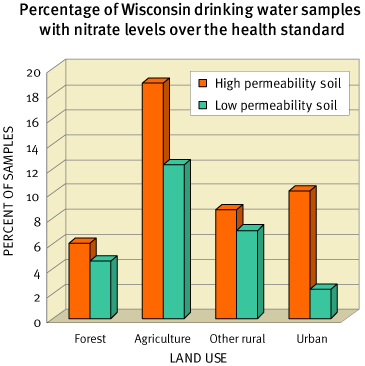 Land
use affects nitrate concentrations in groundwater. As shown in the figure on
the right, an analysis of over 35,000 Wisconsin drinking water samples found
that drinking water from private wells was three times more likely to be unsafe
to drink due to high nitrate in agricultural areas than in forested areas. High
nitrate levels were also more common in sandy areas where the soil is more
permeable.F6 Groundwater
with high nitrate from agricultural lands is more likely to contain pesticides
than groundwater with low nitrate levels.F7 Land
use affects nitrate concentrations in groundwater. As shown in the figure on
the right, an analysis of over 35,000 Wisconsin drinking water samples found
that drinking water from private wells was three times more likely to be unsafe
to drink due to high nitrate in agricultural areas than in forested areas. High
nitrate levels were also more common in sandy areas where the soil is more
permeable.F6 Groundwater
with high nitrate from agricultural lands is more likely to contain pesticides
than groundwater with low nitrate levels.F7
Health effects of nitrate
READ MORE
Human health is the primary reason high levels of
nitrate in drinking water are of concern.F3 Nitrate can cause a condition
called methemoglobinemia, or “blue-baby syndrome,” in infants under
six months of age. Nitrate in water used to make baby formula converts to nitrite
in the child’s stomach and changes the hemoglobin in blood to methemoglobin.
The infant’s body is then deprived of oxygen. In extreme cases, methemoglobinemia
can be fatal; the long-term effects of lower-level oxygen deprivation are unknown.
The conversion of nitrate to nitrite in the human
body also creates N-nitroso compounds, which are some of the strongest carcinogens
known. As a result, additional human health concerns linked to nitrate-contaminated
drinking water include increased risk of non-Hodgkin’s lymphomaF8,
gastric cancerF9, E10, and bladder and ovarian cancer in older women.F11 There
is also growing evidence of a correlation between nitrate and diabetes in children.F12,
E13 The current drinking water limit of 10 mg/L for nitrate-nitrogen addresses
only methemoglobinemia; the concentration at which cancer risks occur is unknown.
Ecosystem effects of nitrate
READ MORE
Nitrate also affects surface water ecosystems by increasing
the growth of nuisance algae that then die and deplete the water of oxygen. Between
the late 1960s and the early 1980s, nitrate levels in waters flowing into the
Gulf of Mexico more than doubled, causing a “dead zone” that in 1999
was approximately the size of the state of New Jersey.F14 In Wisconsin,
the effects of increasing nitrate levels in surface waters are mostly unstudied.
Solutions
READ MORE
Because of the health concerns, public water supplies
that exceed the 10 mg/L limit are required to reduce the nitrate-nitrogen level.
The most common solutions include drilling a new, usually deeper, well; blending
contaminated water with non-contaminated water to lower the nitrate concentration;
or removing nitrate through water treatment processes. However, such solutions
are often costly. By 2006, 25 Wisconsin public drinking water systems had exceeded
the nitrate limit and collectively spent over $24 million on remedies. This number
is up sharply from just 14 in 1999.F3 For information about which
public drinking water systems exceeded the nitrate limit see Money
Spent on Cleanup.
The Wisconsin Well Compensation fund can assist a
private well owner if the nitrate level in his or her well exceeds 40 mg/L (four
times the human health limit), but only if the well is used for livestock watering.
Options for private well owners include replacing or modifying the well, connecting
to a public water supply, installing a water treatment system, or using bottled
water for cooking and drinking.F3
Private well water testing and education programs
offered by the University of Wisconsin – Extension have been successful
in increasing both public awareness of individual nitrate problems and local
government officials’ interest in taking proactive planning steps to protect
groundwater. In Iowa County, for example, town officials began using groundwater
information collected through such programs as criteria for siting new facilities
and developments.F15
Many educational programs have also been put in place
to help farmers limit the loss of nitrogen to groundwater. These programs emphasize
soil testing and proper crediting of nitrogen sources already in place to avoid
overfertilization, and good management practices for fertilizer storage and handling
to minimize spills and other losses. However, numerous researchers have shown
that in central Wisconsin, such best management practices are not always adequate
to prevent contamination of groundwater with nitrate above the drinking water
limit.F16, E17
Recent research on Wisconsin farms has shown that
cattle raising using management intensive grazing (also known as rotational grazing
or grass-fed agriculture) has potential for protecting groundwater from nitrate
contamination.F18 In general, well-managed organic farming practices
also lower nitrate inputs to groundwater,F19, E20 but at times, leaching
from organic systems may also exceed the drinking water limit for nitrate.F21
Some local governments have been successful with
providing incentives to farmers to grow groundwater-friendly crops or otherwise
limit nitrogen applications around city wells. For example, the city of Waupaca
identified fields in the recharge area for its wells and provided various incentives
for farmers to enter into cropping agreements to limit nitrate inputs.F22 A
community may choose to hire a specialist to evaluate nitrate-susceptible areas
and develop possible management strategies.
In addition, three rules currently being proposed
or implemented could decrease nitrate contamination of groundwater:F3
- NR243 (finalized and to be promulgated
in spring 2007) lowers nitrogen levels reaching groundwater from manure and process
wastewater by requiring improved manure storage facilities and prohibiting excessive
or improper application of manure and process wastewater on cropped fields. This
rule will apply to large Concentrated Animal Feeding Operations of 1000 animal
units and larger. Currently, there are about 150 of these permitted operations
in Wisconsin.
- ATCP51 (enacted in April 2006) is a
livestock siting standard that protects areas susceptible to groundwater pollution.
Required standards prevent runoff from entering sinkholes, ensure that existing
storage structures do not leak, and require a manure application plan that minimizes
risks to groundwater, including existing wells. This adopted rule is expected
to apply to about 70 new and expanding farms of more than 500 animal units each
year.
- ATCP50 (still pending as of April 2007)
applies to all farms and includes the requirement for nutrient management plans
by 2008. It incorporates new 2005 USDA NRCS nutrient standards (590 standards)
for both nitrogen and phosphorus application.
Planning
READ MORE
Some nitrate loss from agricultural activities seems
inevitable even with good management practices, especially in areas with coarse-textured
soils or shallow soils over fractured bedrock. From a planning perspective, therefore,
the solutions may lie in keeping new agricultural operations out of the zone
of influence for existing wells, and in avoiding the location of new private
or public wells in areas where nitrate contamination in groundwater has already
occurred.
The 2002 UW-Extension publication titled “Planning
for Natural Resources - A Guide to Including Natural Resources in Local Comprehensive
Planning” gives more details about the following implementation tools that
can be used to address natural resources issues in the planning process:
- Education Tool: Education
and citizen participation in making land use decisions, implementing land use
goals, and taking private actions aimed at limiting nitrate contamination of
groundwater.
- Environmental Assessment Tool: Environmental
assessment requirements within zoning or subdivision ordinances to provide detailed
information about the potential effects of proposed development on nitrate levels
in groundwater, or to ensure that suitable sources of water for private wells
are available on a proposed development site.
- Facility Planning Tool: More
detailed facility plans for potential contamination sources, such as spill containment
plans for potential nitrate sources.
- Regulatory Tools, including:
- Zoning
- Performance zoning, which outlines
general water quality goals that developers or other landowners can meet by a
variety of methods.
- Overlay zoning, which allows special
regulations of sensitive environmental areas such as wellhead protection districts
or groundwater recharge areas.
- Planned Unit Developments may allow
developers to vary some of the standards in local zoning ordinances to allow
innovative approaches that may better protect groundwater.
- Subdivision regulations could include requirements
for adequate and safe water supply and wastewater disposal and treatment facilities,
as well as addressing land suitability and environmental and design issues. (For
further information on subdivisions’ impacts on groundwater, see footnote
#3).
- Increased nitrate treatment by onsite wastewater
systems could be encouraged with financial incentives or density bonus incentives,
although the current Wisconsin Administrative Code (Comm 85.035) does not allow
such systems to be required.F23
- Density transfers can allow the transfer
of development rights from one parcel that a community wants to protect to another
parcel where the community wants development to occur.
- Acquisition Tools, including:
- Outright purchase of land needed for groundwater
protection by communities or non-profit conservation organizations.
- Conservation easements could limit land
uses to those not likely to contaminate groundwater with excess nitrate.
- Purchase of development rights can protect
land from development with certain types of groundwater-contaminating activities
while allowing the landowner to retain ownership of the land and the ability
to sell or transfer it at any time.
- Eminent domain allows government to take
private property for public purposes with compensation to the owner, even without
the owner’s consent. This tool could be used to acquire critical groundwater
protection areas.
- Fiscal Tools, including:
- Capital improvement programs that help a
community plan and budget for capital improvements such as water supplies and
wastewater treatment facilities.
- Impact fees can require new developments
to pay for improvements needed to serve that development.
- WDNR may provide grant or loan programs
to help communities assess and meet their needs in areas involving sensitive
natural resources such as groundwater.
A community could also consider hiring a specialist
to evaluate areas where groundwater is particularly vulnerable and to identify
agricultural and other strategies to minimize nitrate leaching.
PESTICIDES
- A 2002 study estimated that 62%
of private drinking water wells in the region of Wisconsin that includes Dane
County contained a detectable level of an herbicide or herbicide metabolite.
Pesticides occur in groundwater more commonly in agricultural regions, but can
occur anywhere pesticides are stored or applied.F24
- 531,830 acres of land in Dane County
are in atrazine prohibition areas.F25
Definition and Use
A pesticide is any substance used to kill, control
or repel pests or to prevent the damage that pests may cause.F26 Included
in the broad term “pesticide” are herbicides to control weeds, insecticides
to control insects, and fungicides to control fungi and molds. Pesticides are
used by businesses and homeowners as well as by farmers, but figures for the
amounts and specific types of pesticides used are not generally available on
a county-by-county basis.
A 2005 report indicates that approximately 13 million
pounds of pesticides are applied to major agricultural crops in Wisconsin each
year, including over 8.5 million pounds of herbicides, 315,000 pounds of insecticides,
one million pounds of fungicides, and 3 million pounds of other chemicals (this
last category applied mainly to potatoes).F27 The report also shows
that herbicides are used on 100% of carrots for processing, 99% of potatoes,
98% of cucumbers for processing, 98% of soybeans, 97% of field corn, 89% of snap
beans for processing, 87% of sweet corn, and 84% of green peas for processing.
Insecticides are used on 97% of potatoes, 96% of carrots, and 88% of apples.
Fungicides are used on 99% of potatoes, 88% of carrots, and 89% of apples.
Top five crops by acreage grown
in Dane County in 2005-06
and average pesticide application per crop in Wisconsin.
Commodity
|
Acres |
Pounds of pesticides
applied per acre
(statewide average)
|
| Corn for grain |
186,000
|
2
|
| Soybeans |
80,700
|
1
|
| Corn for silage |
28,600
|
2
|
| Wheat all |
12,500
|
**
|
| Wheat winter all |
12,500
|
**
|
| ** no available data |
| Source: USDA
QuickstatsF45 and USDA
Statistics by StateF46
|
The number of pounds of pesticide applied per acre
in Wisconsin varies greatly by crop, from 28 pounds/acre for apples to less than
one pound/acre for oats and barley (see table below).F27
Total pounds of pesticides
applied to
major crops in Wisconsin, 2004-2005.
|
Crop
|
Acres
|
Total pounds
of pesticides applied
|
Pounds of pesticides
applied per acre
|
| Apples |
5,800
|
163,300
|
28
|
| Potatoes |
68,000
|
950,000
|
14
|
| Tart cherries |
1,800
|
14,700
|
8
|
| Carrots for processing |
4,200
|
29,400
|
7
|
| Snap beans |
76,000
|
251,600
|
3
|
| Sweet corn |
88,400
|
198,000
|
2
|
| Field corn |
3,800,000
|
6,503,000
|
2
|
| Green peas for
processing |
30,200
|
33,500
|
1
|
| Soybeans |
1,610,000
|
1,770,000
|
1
|
| Cucumbers for processing |
4,600
|
3,800
|
1
|
| Cabbage, fresh |
4,400
|
2,700
|
1
|
| Barley |
55,000
|
5,000
|
<1
|
| Oats |
400,000
|
25,000
|
<1
|
Atrazine Prohibition Areas
As of 2006, the WDATCP has prohibited the use of the
popular corn herbicide atrazine on 102 designated atrazine prohibition areas
in Wisconsin, covering about 1.2 million acres.F25 The
map below shows the 531,830 acres of land located in atrazine prohibition
areas in Dane County.
Environmental fate of pesticides
Once a pesticide is applied, it ideally will harm
only the target pest and then break down through natural processes into harmless
substances.
However, the actual fate of pesticides in the environment
may include evaporation into the air; runoff into surface water; plant uptake;
breakdown by sunlight, soil microorganisms or chemical reactions; attachment
to soil particles; leaching into groundwater; or remaining on the plant surface
and removal at harvest.
The WDATCP conducted a private well water study from
2000-2001, looking for some of the most commonly used herbicides in Wisconsin.F29 From
that study, the statewide estimate of the proportion of private drinking water
wells that contained a detectable level of a herbicide or herbicide metabolite
(breakdown product) was 37.7%. The map at the right shows the estimated percentage
of wells containing herbicide or herbicide metabolites by region. The study did
not look at less commonly used herbicides or any insecticides or fungicides.
WDATCP is doing a similar study in 2007 that includes analysis for a greater
number of pesticides.
READ MORE
How much of a pesticide application will leach to
groundwater depends upon four factors:F30
- pesticide properties such
as high water solubility, low adsorption (the ability of a pesticide to attach
to soil particles), and high persistence (how long it takes for the chemical
to degrade)
- soil characteristics such
as high permeability and porosity, low soil compaction, low amounts of organic
material, and high amounts of sand and gravel content
- site conditions such
as shallow depth to groundwater, high amount of precipitation, and excessive
irrigation
- management practices such
as poor timing of pesticide application, not incorporating the pesticide into
the soil, poor handling of the chemical, and solely relying on chemicals for
pest control
Determining which pesticides are in groundwater at
a given location and time is difficult and can be expensive. A pesticide test
generally looks for a single chemical, or more commonly, a broad group of chemicals,
but not all pesticides are detected by any one test. Pesticides break down over
time into metabolites which may not have the same testing method as the parent
compound. Further, some pesticides do not have approved testing methods, so they
cannot be measured in water.
Health effects of pesticides
READ MORE
The health effects of pesticide exposure vary by pesticide.
For example, atrazine, a common corn herbicide, has been linked to weight loss,
cardiovascular damage, retinal and some muscle degeneration, and cancer when
consumed at levels over the drinking water limit for long periods of time.F31 Long-term
exposure to alachlor, another herbicide, is associated with damage to the liver,
kidney, spleen, and the lining of the nose and eyelids, and cancer.F32 Only
about 30 pesticides currently have health-based drinking water limits in Wisconsin,
so occasionally, pesticides are detected in drinking water, but their harmful
levels or health effects are unknown. Also unknown are the health effects of
a combination of pesticides in drinking water, even at levels below the drinking
water limit for any one of the pesticides.
To learn more about pesticides, please see
Planning
READ MORE
Goals for groundwater protection from pesticides
may include:
- Determine what pesticides are being
used and where. Test wells in these areas for these pesticides and their metabolites.
- For pesticides with established drinking
water limits, keep concentrations below the drinking water limit.
- Encourage and support the use of organic
farming methods in the county.
- Limit use of lawn pesticides (perhaps
by limiting lawn size).
Implementation tools
Because of differences in pesticides, soils, and management
practices, knowing which crops are grown in an area alone does not accurately
indicate the risk to human health. However, knowing where pesticide use is likely
to be heaviest may be useful in comprehensive planning if one of the goals is
to minimize human exposure to potential contaminants in the environment.
Implementation tools that can be used to address groundwater
issues in the planning process may include:
- Education Tool: Education
and citizen participation in making land use decisions, implementing land use
goals, and taking private actions aimed at limiting pesticide contamination of
groundwater.
- Private well water testing and education
programs offered by the University of Wisconsin – Extension can increase
public awareness of pesticide contamination in groundwater and local government
officials’ interest in taking proactive planning steps to protect groundwater.
In Iowa County, for example, town officials began using groundwater information
collected through such programs as criteria for siting new facilities and developments.F15
- The University of Wisconsin – Madison
and UW - Extension have many educational programs in place to help farmers limit
the use of pesticides and pesticide losses to the environment,F33 such
as the Integrated Crop and Pest Management (ICPM) program, which can be accessed
and implemented locally through the county Extension office.
- Environmental Assessment Tool:
Environmental assessment requirements within zoning or subdivision ordinances
to ensure that suitable sources of water for private wells are available on a
proposed development site.
- Facility Planning Tool:
More detailed facility plans for potential contamination sources, such as spill
containment plans for potential pesticide sources.
- Regulatory Tools: including
- Zoning
- Performance zoning, which outlines general
water quality goals that developers or other landowners can meet by a variety
of methods.
- Overlay zoning, which allows special regulations
of sensitive environmental areas such as wellhead protection districts or groundwater
recharge areas.
- Density transfers can allow the transfer
of development rights from one parcel that a community wants to protect to another
parcel where the community wants development to occur.
- Acquisition Tools, including:
- Outright purchase of land needed for groundwater
protection by communities or non-profit conservation organizations.
- Conservation easements could limit land
uses to those not likely to contaminate groundwater with pesticides.
- Purchase of development rights can protect
land from development with certain types of groundwater-contaminating activities
while allowing the landowner to retain ownership of the land and the ability
to sell or transfer it at any time.
- Eminent domain allows government to take
private property for public purposes with compensation to the owner, even without
the owner’s consent. This tool could be used to acquire critical groundwater
protection areas.
- Fiscal Tools: including
WDNR grant or loan programs to help communities assess and meet their needs in
areas involving sensitive natural resources such as groundwater.F34
- Incentive Tools: Incentives
from local governments to grow groundwater-friendly crops including
- A community could identify agricultural
lands in the recharge area for its wells and provide various incentives for farmers
to enter into cropping agreements to limit pesticide inputs.
- Woodbury County, Iowa offers property tax
rebates to farmers who switch to organic methods.F35
- A community may hire a specialist to evaluate
areas of high pesticide use and develop possible pesticide management strategies
or promote low-pesticide agricultural systems or organic farming systems which
forbid the use of synthetic pesticides.
- A community may encourage food processors
that purchase organic or groundwater friendly foods to locate or form in the
area.
ARSENIC
- 100% of 34 private
well samples collected in Dane County met the health standard for arsenic.F43
Of the 34 water samples analyzed for arsenic in Dane County,
4 have detectable arsenic, and no samples are greater than the recently reduced
drinking water limit of 10 µg/L (micrograms per liter, or parts per billion).F44
Most private wells in the county have
unknown arsenic levels.
Introduction
Arsenic is an element that occurs naturally in some
of Wisconsin’s aquifers and may contaminate well water drawn from those
aquifers. It is a particular problem in parts of the Fox River valley of northeastern
Wisconsin. However, arsenic has been detected in wells in every county in Wisconsin,
and arsenic concentrations greater than the drinking water limit of 10 µg/L
have been documented in 51 of Wisconsin’s 72 counties.F3
Health effects of arsenic
READ MORE
Drinking water with elevated levels of arsenic may
lead to a variety of health effects, including:F36 skin cancer, internal
cancers (bladder, prostate, lung, and other sites), thick, rough skin on hands
and feet, unusual skin pigmentation (dappling of dark brown or white splotches),
numbness in the hands and feet, circulatory disorders, tremors, stomach pain,
nausea, diarrhea, diabetes, depression.
Release of arsenic into groundwater
READ MORE
In northeastern Wisconsin, most of the arsenic is
found in a highly mineralized zone at the top of the St. Peter Sandstone aquifer.
The oxidation mechanism that releases arsenic occurs naturally in some cases,
but can also be triggered by either:F3
- Local and regional drawdown (drop in
water level) caused by increasing water use, which exposes the arsenic-bearing
zone to the atmosphere or
- Well construction techniques that introduce
oxygen into the aquifer.
However, revised WDNR drilling rules and special
well casing requirements have greatly reduced well construction problems.F44 Maps
are available from the WDNR that show special well construction and well
casing requirements by section for towns in Winnebago and Outagamie Counties.
In southeastern Wisconsin and the glacial moraines
of northern Wisconsin, the mechanism by which arsenic is released from geologic
materials is different. The arsenic is associated with iron oxides and is released
by natural reduction reactions that cannot readily be prevented or controlled.F3,
E38, E39 In such areas, alternatives are limited to treating water or using
another (often shallower) aquifer, if one is present and not contaminated with
nitrate or other human-induced contaminants.
Planning
READ MORE
Arsenic contamination could be addressed in comprehensive
planning in the following ways:
- Maps and other resources can be consulted
to determine the likelihood of arsenic contamination of drinking water supplies
in areas designated for residential development, and possible need for alternate
water supplies in those areas.
- Generalized
maps can be found on the WDNR web site for both public and private water
supplies sampled until 2000.
- Madeline Gotkowitz (mbgotkow@wisc.edu,
608/262-1580) at the Wisconsin Geological and Natural History Survey has done
extensive research and public outreach on arsenic problems in Wisconsin’s
groundwater.
- Testing and education programs can
be conducted for owners of existing private wells in arsenic-prone areas to check
current arsenic levels in private wells, to advise about treatment options, and
to inform about ways to limit further arsenic release in the aquifer, where applicable.
- Restricting residential growth, encouraging
or mandating water conservation, or finding alternate water sources may be beneficial
in areas where oxidation is the primary method of arsenic release.
For further information on arsenic, please visit the WDNR
Arsenic in Drinking Water and Groundwater web site.
OTHER GROUNDWATER CONTAMINANTS
Information on volatile organic compounds, pharmaceuticals
and personal care products, and chloride.
READ MORE
Volatile Organic Compounds
Volatile organic compounds (VOCs) are a group of common industrial and household
chemicals that evaporate, or volatilize, when exposed to the air. Sources of
VOCs include a variety of everyday products such as gasoline, fuel oil, solvents,
degreasers, and dry cleaning solutions. When chemicals containing VOCs are spilled
or disposed of on or below the land surface some of the chemicals can be carried
down into the groundwater where they may pose a threat to nearby wells. Some
VOCs are quite toxic while others pose little risk. Health risks vary depending
on the type of VOC, but effects of long-term exposure can include cancer, liver
damage, spasms, and impaired speech, hearing, and vision.F40
Pharmaceuticals and Personal Care Products
The list of pharmaceuticals is long and includes such medications as tranquilizers,
pain killers, antibiotics, birth control, hormone replacement, lipid regulators,
beta blockers, anti-inflammatories, chemotherapy, antidiabetics, seizure control,
veterinary drugs, antidepressants, and other psychiatric drugs. There is a related
category of chemicals referred to as "personal care products" that
includes cosmetics, perfumes, soaps, sunscreens, insect repellants, and so forth.
The volume of pharmaceuticals and personal care products entering the environment
each year is about equal to the amount of pesticides used.
In 2000 the U.S Geological Survey conducted a nationwide
assessment of drugs in streams and groundwater. They picked locations likely
to be contaminated, but found pharmaceuticals in about 60% of groundwater samples.
Sources of discharge of pharmaceuticals to the environment include wastewater
treatment plants, onsite wastewater treatment systems, landfills, sludge and
manure spreading, and livestock feedlots. Why be concerned about traces of chemicals
that were designed to be consumed? We're only beginning to understand the health
effects. Because of the low concentrations, any effects are likely to appear
only after years of exposure. A real concern is that some of the drugs are endocrine
disruptors. Endocrine glands, such as the thyroid, pituitary or thymus send hormones,
such as adrenaline, estrogen or testosterone to specific cells stimulating certain
responses. There are hundreds of different hormones, and they are messengers
that regulate a multitude of normal biological functions, such as growth, reproduction,
brain development, and behavior. The delivery of hormones to various organs is
vital, and when the delivery, timing, or amount of hormone is upset, the results
can be devastating and permanent. Chemicals that are similar to hormones ("hormone
mimics") can fit onto the receptor sites on the target cells and either
block the real hormones or trigger abnormal responses in the cells. Scientific
studies have indicated links between endocrine disruptors and reproductive disorders,
immune system dysfunction, certain types of cancer, congenital birth defects,
neurological effects, attention deficit, low IQ, low sperm counts, and early
onset of puberty in girls.F41
Chloride
Chloride at levels greater than 10 mg/L usually indicate contamination by onsite
wastewater treatment systems (including water softener regeneration), road salt,
fertilizer, animal waste, or other wastes. Chloride is not toxic in concentrations
typically found in groundwater, but some people can detect a salty taste at 250
mg/L. Levels of chloride that are above what is typical under natural conditions
indicate that groundwater is being affected by human activities, and extra care
should be taken to ensure that land use activities do not further degrade water
quality.F42
return to top
|
| |
POTENTIAL
SOURCES OF CONTAMINANTS
Since groundwater gets into the ground at the land
surface, it makes sense that what happens on the land surface can have impact
on groundwater. A great many land use activities have the potential to impact
the natural quality of groundwater, as shown in the table below.
A landfill may leach contaminants into the ground that end up contaminating groundwater.
Gasoline may leak from an underground storage tank into groundwater. Fertilizers
and pesticides can seep into the ground from application on farm fields, golf
courses or lawns. Intentional dumping or accidental spills of paint, used motor
oil, or other chemicals on the ground can result in contaminated groundwater.
The list could go on and on.G1 The
rest of this section provides county-specific information about potential sources
of groundwater contaminants.
ACTIVITIES THAT MAY CONTAMINATE GROUNDWATERG1
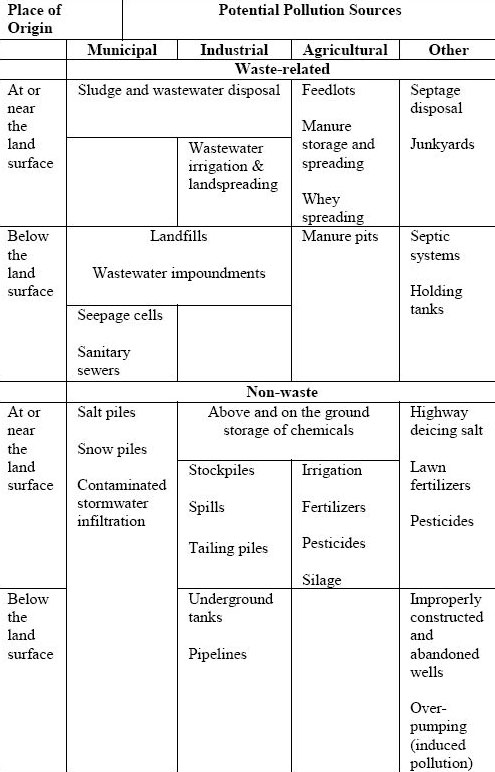
CONTAMINATED GROUNDWATER AND/OR SOIL
- There are 262
open-status sites in Dane County that have contaminated groundwater and/or soil.
These sites include 156 Leaking Underground Storage Tank (LUST) sites, 99 Environmental
Repair (ERP) sites, 4 spill sites, and 3 Voluntary Party Liability Exemptions
(VPLE) sites.G2
Properties that were or are contaminated with hazardous
substances can be found using the WDNR's Bureau for Remediation and Redevelopment
Tracking System (BRRTS). The figure on the right shows the BRRTS map of contaminated
sites in Dane County. Royal blue diamonds on the map indicate open leaking
underground storage tank (LUST) sites which have contaminated soil and/or groundwater
with petroleum, which includes toxic and cancer-causing substances. However,
given time, petroleum contamination naturally breaks down in the environment.
Turquoise diamonds on the map indicate open environmental repair (ERP) sites
which are sites other than LUSTs that have contaminated soil and/or groundwater.
Examples include industrial spills or dumping, buried containers of hazardous
substances, and closed landfills that have caused contamination. More information
for the sites on the figure is available
online.
About the BRRTS
READ MORE
The WDNR Bureau of Remediation and Redevelopment Tracking System (BRRTS) contains information about locations at which there have been releases of hazardous or potentially hazardous substances to the lands, waters, or air of the State of Wisconsin. Degradation of groundwater quality is one of the primary concerns at BRRTS sites, but soil, vapor, air, and surface water contamination are also areas of concern.
What is a Hazardous Substance?
READ MORE
A Hazardous Substance is defined in s. 292.01, Wis. Stats., as “any substance or combination of substances, including any waste of a solid, semisolid, liquid or gaseous form which may cause or significantly contribute to an increase in the mortality or an increase in serious irreversible or incapacitating reversible illness, or which may pose a substantial present or potential hazard to human health or the environment because of its quality, concentration or physical, chemical or infectious characteristics. This term includes, but is not limited to, substances that are toxic, corrosive, flammable, irritants, strong sensitizers or explosives as determined by the WDNR.”
Types of hazardous substance occurrences or discharges that are documented in the BRRTS database include:
- Abandoned Container (AC) – an abandoned container with potentially hazardous contents has been inspected and recovered, but discharge to the environment has not occurred.
- Leaking Underground Storage Tank (LUST) – a leaking underground storage tank has contaminated soil and/or groundwater with petroleum. Petroleum products contain cancer-causing and toxic substances, but may biodegrade, or break down naturally in the environment, over time.
- Environmental Repair (ERP) – sites other than LUSTs that have contaminated soil and/or groundwater. Industrial spills or dumping, buried containers of hazardous substances, closed landfills, and leaking above-ground petroleum storage tanks are potential ERPs.
- Voluntary Party Liability Exemption - an elective process in which a property owner conducts an environmental investigation and cleanup of an entire property and then receives limits on future liability for that contamination.
- Spills – discharges of hazardous substances, usually cleaned up quickly.
For further information, see the BRRTS
web site glossary.
How to use BRRTS information in comprehensive planning
READ MORE
BRRTS information provides a snapshot of contaminated sites that need to be considered when developing land use plans. Steps toward incorporating BRRTS information into a comprehensive plan include
- Inventory contaminated sites and identify their status.
The summary document prepared for each county on this web site lists BRRTS sites that are still open. Other sites of interest may include closed sites and conditionally closed sites on the BRRTS list, or sites in the community that have not yet been investigated by WDNR but are suspected to have had hazardous releases in the past.
- Identify land use restrictions and deed restrictions assigned to contaminated properties. Land use restrictions are placed on BRRTS sites to protect public health and the environment. A BRRTS site that is “closed” and requires no further cleanup action may still have residual soil or groundwater contamination. If it does, it is moved to the GIS Registry of Closed Remediation Sites. Sites on the Registry have restrictions that may include
- site maintenance plans
- requirement for WDNR approval before new well construction
- special required well construction features
- special precautions when excavating soils
Details about such restrictions are available in the GIS
Registry of Closed Remediation Sites fact sheet.
- Identify properties on which redevelopment would be desirable for the community. Communities may be eligible for assistance in redeveloping contaminated or formerly contaminated industrial or commercial sites that are abandoned, idle or underused through WDNR initiatives aimed at brownfield redevelopment. Helpful tools for redevelopment include
- environmental liability exemptions
- financial incentives
- WDNR assurance letters
Details on programs to help with brownfield redevelopment are found in the WDNR publication Danefields and Comprehensive Planning
A list
of WDNR staff contacts to assist with various aspects of remediation and redevelopment of contaminated sites, including assistance grants for local governments, is available online.
For more information, please see Environmental
Contamination – The Basics, WDNR publication PUB-RR-674 July, 2004.
CONCENTRATED ANIMAL FEEDING OPERATION (CAFO):
- There are 7 concentrated
animal feeding operations in Dane County.G3
ABS Global, Inc.
1525 River Road
DeForest, WI 53532
Type: Beef
Blue Star Dairy Farms
7502 Patton Rd
DeForest, WI 53532
Type: Dairy
Daybreak Foods, Inc.
533 Tyranena Road
P O Box 800
Lake Mills, WI 53551
Type:
Chickens
Kippley Farms
6137 CTY K
Waunakee, WI 53597
Type: Beef
Ripps Dairy
Valley
6626 Ripp Dr
Dane, WI 53529
Type: Dairy
STATZ BROTHERS, INC.
6075 Skala
Road
SUN PRAIRIE, WI 53590
Type: Dairy
Wagner Dairy Farm
7262 Schneider Rd
Middleton, WI 53562
Type: Dairy
By
definition, CAFOs have greater than 1000
animal units. CAFOs are required under
their Wisconsin Pollutant Discharge Elimination System (WPDES) permits to practice
proper manure management and ensure that adverse impacts to water quality do
not occur. Permit applicants must submit detailed information about the
operation, a manure management plan, plans and specifications for all manure
storage facilities, and a completed environmental analysis questionnaire. Once
a WPDES CAFO permit is issued, operators must comply with the terms of the permit
by following approved construction specifications and manure spreading plans,
conducting a monitoring and inspection program, and providing annual reports.
Other
potential groundwater contaminants from agriculture include fertilizers and
pesticides. Large amounts of nitrogen fertilizers are used when fields are planted
continuously with corn, and they can leach into groundwater as nitrate.
For more information, please visit the WDNR
CAFO web site.
LICENSED LANDFILLS
- There are 2 licensed
landfills in Dane County.G4
DANE CNTY LF #2
RODEFELD
7102 USH 12 & 18
MADISON,
WI 53718
W M W I - MADISON PRAIRIE
6002 NELSON RD
SUN PRAIRIE, WI 53590
The county may have additional facilities listed in
the Registry of Waste Disposal Sites, available from the WDNR, that includes
active, inactive, and abandoned sites where solid or hazardous wastes were known,
or were likely, to have been disposed. The inclusion of a site on the Registry
does not mean that environmental contamination has occurred, is occurring, or
will occur in the future. The Registry is intended to serve as a general informational
source for the public, and State and local officials, as to the location of waste
disposal sites in Wisconsin.
About Wisconsin's Solid Waste Management Program
READ MORE
Wisconsin's solid waste management program has been in place for over 30 years. In the first two decades of the program, efforts were primarily directed toward: licensing existing solid waste facilities; closing poorly located or operated facilities; and ensuring that new solid waste facilities were properly located, designed, constructed, operated, closed, and maintained. During this period, the vast majority of municipal and industrial solid waste generated was landfilled.
In the 1990s, things began to change. Wisconsin's Recycling Law was passed in 1990, with most of the requirements taking effect in 1995. In 1997, ch. NR 538, Wis. Adm. Code was promulgated, facilitating the beneficial use of industrial byproducts. These two milestones resulted in significant and still-increasing quantities of waste being diverted from landfills.
As of the summer of 2001, Wisconsin has the following
numbers of licensed/regulated facilities in operation: 44 municipal solid waste
landfills; 41 industrial waste landfills; 36 construction and demolition waste
landfills; 1,446 solid waste transporters; 78 transfer stations; 64 processing
facilities; 6 municipal waste combustors; 148 composting facilities (mostly yard
waste); and 125 woodburning sites.G5
The solid waste program strives to ensure proper management of solid waste and works with its customers to increase waste reduction, reuse, and recycling. For more information on solid waste management in Wisconsin, see the Future of Waste Management Study completed in 2001.
A complete
list of licensed landfills in Wisconsin for 2007 can be found online.
More
information on solid waste is available from the WDNR.
SUPERFUND SITES
- There are 5 Superfund
sites in Dane County.G6
City Disposal Corp. Landfill located in the Dunn Township, Wis.
Stoughton City Landfill located in Stoughton, Wis.
Hagen Farm located in Stoughton, Wis.
Madison Metro Sludge Lagoons located in Madison, Wis.
Refuse Hideaway Landfill located in Middleton, Wis.
What is Superfund?
READ MORE
In 1980, Congress passed the Comprehensive Environmental Response, Compensation, and Liability Act (CERCLA), commonly known as the Superfund law. The Superfund law created a tax on the chemical and petroleum industries. The tax went into a trust fund to help pay for cleaning up abandoned or uncontrolled waste sites.
The U.S. Environmental Protection Agency (EPA) administers the Superfund trust fund and works closely with state and local governments and tribal groups to remediate sites that may endanger public health or the environment. The contamination at many of these sites was created years ago when environmental regulations were virtually nonexistent and companies dumped or emitted hazardous materials freely into the environment. Years later the threat to humans and the ecosystems remains so great that the sites need to be cleaned up.
Unfortunately, since much of this contamination was caused so many years ago, it can be hard to find the parties responsible, or the parties responsible may be unwilling or unable to pay for the cleanup. In these cases, the Superfund trust fund can be used to pay for most of the cleanup process. States must pay for a portion of such cleanups.
CERCLA also provides EPA with enforcement tools to compel those responsible for causing the contamination to pay for the cleanup, including the issuance of administrative orders. If the trust fund is used, then EPA and the state may go to court to recover their expenditures from those who are responsible.G7
return to top
|
| |
NEXT STEPS
Now that you’ve inventoried groundwater data
and analyzed it, what’s next? How do you use this information to lead to
on-the-ground actions?
Now comes the key part of the planning process, where
it’s important to involve as many community members as possible to develop
and implement a plan of action to protect groundwater. The following sections
of this web site are intended to help your community move forward together to
protect groundwater.
return to top
|
|









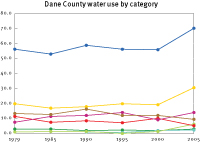
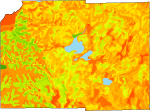

 Land
use affects nitrate concentrations in groundwater. As shown in the figure on
the right, an analysis of over 35,000 Wisconsin drinking water samples found
that drinking water from private wells was three times more likely to be unsafe
to drink due to high nitrate in agricultural areas than in forested areas. High
nitrate levels were also more common in sandy areas where the soil is more
permeable.
Land
use affects nitrate concentrations in groundwater. As shown in the figure on
the right, an analysis of over 35,000 Wisconsin drinking water samples found
that drinking water from private wells was three times more likely to be unsafe
to drink due to high nitrate in agricultural areas than in forested areas. High
nitrate levels were also more common in sandy areas where the soil is more
permeable.